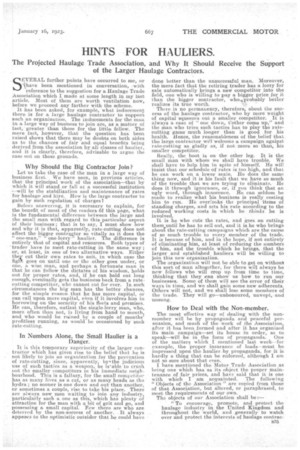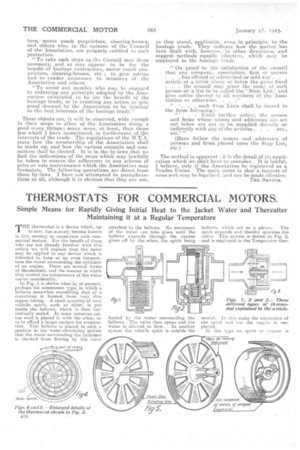HINTS FOR HAULIERS.
Page 21

Page 22

If you've noticed an error in this article please click here to report it so we can fix it.
The Projected Haulage Trade Association, and Why It Should Receive the Support of the Larger Haulage Contractors.
SEVERAL further points. have occurred to me, or (have been mentioned in conversation, -with reference to the suggestion for a Haulage Trade Association which I made at some length in my last article. Most of them are worth ventilation now, before we proceed any.farther with the scheme.
It has been asked, for example, what inducement there is for a large haulage contractor to support Ruch an organization. The inducements for the man in a large way of business to join are, as a matter of fact, greater. than those for the little fellow. • The mere fact, however, that the question has been raised shows that there may he doubts on both sides as to the chances al fair and equal benefits being derived from the association by all classes of haulier, and it is clearly, therefore, advisable to argue the case out on those grounds.
Why Should the Big Contractor Join?
Let us take the case of the man in a large way of business first. We have seen, in previous articles, that the principal work of the association—that by -which it will stand or fall at a successful institution —will be the stabilization and maintenance of rates for haulage and hire. How is the large contractor to gain by such regulation of charges?
Before answering, it is necessary to explain, for the benefit of most of the readers...of this page, what is the fundamental difference between the large and the small man with regard to this particular aspect of their business ; that is to say, I must show how and why it is that, apparently, rate-cutting does not affect the bigger contrantor so vitally as it does the " one-man," " one-lorry" haulier. The difference is entirely that of capital and regources. Both-types of 'trader have to meet rate-cutting in the same way; or, at least, in_ one of two alternative ways. Either they cut their own rates to Suit, in which ease the figIF., goes on until one or the other gOes under, or one, a wise_ man, and perhaps. a fortunate man in that he can follow the dictates of his wisdom, holds out for proper rates, and, if he can hold out long enough, eventually gets the business back from a ratecutting competitor, who cannot cut for ever. In such circumstances the big man has the better chances, for the simple reason that he has more capital, or can call upon more capital, eVen if it involves him in borrowing on the security of his fleets and premises. He can, therefore, outlast the single-lorry man, who, more often than not, is living from hand to mouth, and who would be ruined by acouple of months' profitless running, as would be occasioned by such rate-cutting.
In Numbers Alone, the Small Haulier is a Danger.
It is this temporary superiority of the larger contractor which has given rise to the belief that be is not likely to join an organization for the prevention of rate-cutting, since, apparently, bytthe judicious use of such tactics as a -weapon, he israble to crush out the smaller competitors in his immediate neighbourhood. This is a fallacy, for the small competitor has as many lives as a cat, or as many heads as the hydra ; no sooner is one down and out than another, Or sometimes a couple, rise to take his place. There are always new men waiting to loin any industry, particularly such a one as this, which has plenty of attraction for the man with a bit of grit and go, and possessing a small capital. Few there are who are deterred by the non-success of another. It always appears-to the optimistic outsider that he could have done better than the unsuccessful man. Moreover,
the mere fact that the retiring trader has a lorry for sale automatically brings a nem:, competitor into the field, one who is willing to pay a bigger price for it than the bigger contractor, wholprobably betier realizes its true worth.
• There is no permanency, therefore, about the success of the haulage contractor, who by mere weight of capital squeezes out a smaller competitor. It is always a case of " one down, Vother come up," and the man who tries such tactics has to play the ratecutting game much longer than is good for his health. Hence, the reasonableness of the belief that the large contractor will welcome a campaign against rate-cutting as gladly as, if not:. more so than, his smaller competitor.
Really, the boot ia on the other leg. It is the small man with whom we shall have trouble. We shall have to help him in spite of himself. He will insist that our schedule of rates is too high, and, that he can work on a lower scale. He does the same thing now, and it is his fault that we have so much of the trouble that we are trying to eliminate. He does it threugh ignorance, or, if _you think that an ugly word, through innocence. He can seldom be made to realize what his business is really costing him to run. Ire overlooks the principal items of standing'charges, and sets his rate according to the reduced working costs in which he thinks he is involved.
It is he who cuts the rates, and goes on cutting thern.until he has to sell out, and it is he who brings about the rate-cutting campaigns which are the cause of so much trouble to every member of the trade. It is because of him, and in the hope, if not entirely of eliminating him, at least of reducing the numbers of him, and the trouble which he brings, that the larger and established hauliers will be willing to join this new organization.
The organization will not be able to get on without this sort of man altogether, for there will always be new fellows who will crop up from time to time, thinking that they ran show us how to run our businesses. Some of them will see the error of their ways in time, and we shall gain some new adherents. Others will not, and we shall lose some members of the trade. They will go—unhonoured, unwept, and unsung.
How to Deal with the Non-member.
The most effective way of .dealing with the nonmember will be by propaganda and peaceful persuasion, and much of the work of the Association, after it has been farmed and after it has organized its main campaign—set its house in order, so to speak—will be in the form of propaganda. One of the matters which I mentioned last week--for example, the proper insurance of loads—must be impressed upon the haulier by propaganda, for it is hardly a thing that can be enforced, although I am not so sure about that even.
I have mentioned the Motor Trade Association as being one which has as its object the proper maintenance of fair prices, and have said that it is one with which I am acquainted. The following " Objects of the Association "are 'copied from those of that Association, but altered, or paraphrased, to meet the requirements of our own. The objects of our Associationshall be " To encourage, promote, and protect the haulage industry in the United Kingdom and throughout. the world, aud ,generally to watch over and protect the interests of haulage contrac tors motor coach proprietors, clearing-houses,. and others who, in the opinion of the Council of the Association, are properly entitled to such protection.
" To take such steps as the Council may deem necessary; and as may appear to be for the benefit of haulage contractors, motor coach proprietors, clearing-houses, etc.; to give advice and to render assistance to members of the Association and others.
" To assist any member who may be engaged in enforcing any principle adopted by the Association calculated to be for the benefit of the haulage trade, or in resisting any action or proposal deemed by the Association to be inimical to the best interests of the haulage trade."
These objects are, it will be observed, wide enough in their scope to allow of the Association doing a good many things; many more, at least, than those few which I have enumerated, in furtherance of the interests of the trade. The regulations of the M.T.A. state how the membership of the Association shall be made up, and how the various councils and committees shall be elected. It is in the by-laws that we find the indications of the steps which may lawfully be taken to ensure the adherence to any scheme of price or rate maintenance which the Association may formulate. The following quotations are direct from those by-laws. I have not attempted to paraphrase them at all, although it is obvious that they are not-, as they stand, applicable. even in principle, to the haulage trade. They indicate how the matter has been dealt with, however,in other directions, and suggest methods equally effective, which may be employed in the haulage trade.
" On proof to the satisfaction of the council that any company, association, firm or person _ . . . has offered or advertised or sold any . . article at a price above or below the price fixed . . . the council may place the name of. such person on a list to be called the Stop List,' and give notice thereof to all members of the Association or otherwise. • . ."
. . . such Stop Lists shall be issued in the form following.: - . Until further notice, the person and firms whose names and addresses are. set out below are not to be supplied 'directly or . indirectly with any of the articles . . . . etc., etc.' " (Here fallow the names and addresses of persons and firms placed upon the Stop List, etc.) The method is apparent ; it is the detail of its application which we shall have to consider. It is lawful, I believe, only if the Association be registered as a Trades Union. The main point is that•a boycott of some sort may he legalized, and can be made effective. THE SIWTCH.






























